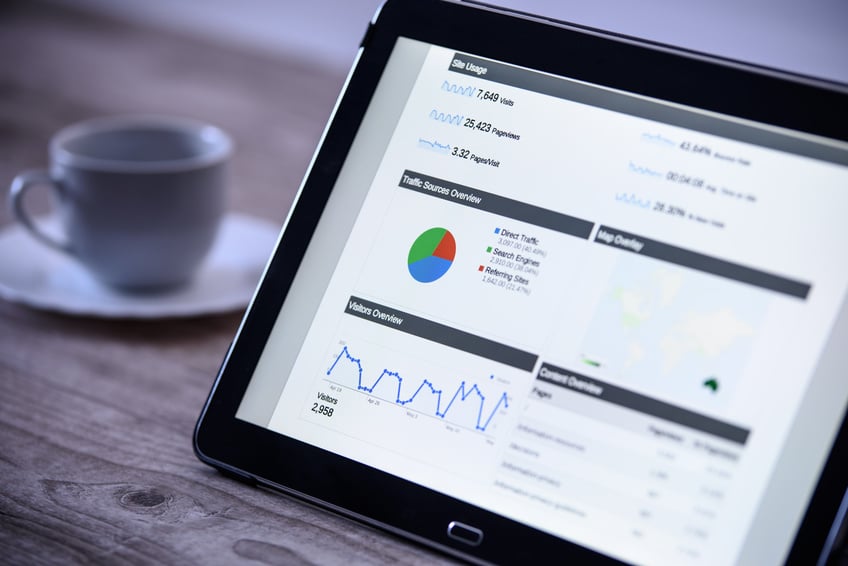How to Effectively Use Analytics Tools
Analysing, measuring and refining a digital marketing campaign is rarely the most exciting part of the process of increasing on-site traffic and conversion, but its importance cannot be downplayed. Digital marketing is wonderfully competitive and almost bewilderingly fast-paced, meaning it’s important that all campaigns and techniques are analysed and measured in a timely and accurate manner.
A scattergun approach to digital marketing is unlikely to get you, your brand and your website very far – so a sizeable splash of science must be added to the process, from the very first step of the journey.
Whether you are implementing SEO, PPC, Content Marketing, CRO or a cocktail using any of these ingredients, it is vital that you have an understanding of the analytics tools available, or at least a professional you trust to navigate the stats and figures. This will help guide your processes, streamline practices and help increase the chance of future wins.
So, to help you correctly interpret the stats and figures using Google’s own tools as well as a couple of third-party platforms, we’ve put together a guide to effectively using analytics tools.
Quick Navigation
- Google Analytics
- Understand the Lingo
- Create Time-Specific Parameters
- Create Timeframes and Decipher the Figures
- Understand your User
- Streamline your Reports
- ResponseTap
- Consider your Requirements
- Intergrate with Google Analytics and AdWords
- Optimizely
- Qauntcaster
Google Analytics
This free tool from Google is heavily relied upon by websites of all sizes from small, niche bloggers to massive multinational corporations. Tracking and reporting website traffic, Google Analytics has become the world’s most widely used web analytics tool since its launch in 2005. It is possible to chart a website’s performance across a selection of criteria including unique visits, sales and click-throughs.
Not only can Google Analytics help you identify where your website is succeeding and where it is underperforming, but it can also help you streamline and focus your website to improve the customer journey from first contact to final goal.
A huge tool, with plenty of scope, Google Analytics can be useful for beginners, intermediary users and even experts with the different levels and resources available. Here are a few key tips to help you get the most from Google Analytics, whatever your level.
Understand the Lingo
The first step to a harmonious relationship with Google Analytics (and the majority of web analysis tools) is familiarising yourself with some of the most important and most common terms used on the platforms. Here’s some of the borderline jargon which may have you reaching for the search marketing dictionary.
Metrics – The performance elements which can be measured by a sum or a ration, these can include number of site views, sales and much more.
Users – Visitors with at least one session on your website within the selected timeframe.
Pages/Sessions – Also known as Average Page Depth, this is the average number of different pages a user visited during their session on your website.
Bounce Rate – The percentage of visitors to your website who did not interact with the site. Naturally, the lower the figure, the better.
New Sessions – First-time visitors to your website.
Goals – Measurable and editable objectives for your website. These can include anything from newsletter sign-ups to on-site purchases.
Conversions – The number of times the set goals have been achieved.
Armed with an updated digital vernacular, you’ll have a greater chance of understanding the Google Analytics dashboard.
Create Time-Specific Parameters
To really understand how your website is performing, it’s important to monitor and record the figures across set time periods. Measuring both monthly and yearly, it is possible to identify whether your site is achieving its desired upwards trajectory. This can be done on the Google Analytics homepage, adjusting the date above the list of URLs.
Month-by-month analysis is particularly effective for websites which are affected by seasonality. Understanding when your website is most popular can help you identify when to make big marketing pushes or investments.
Compare Timeframes and Decipher the Figures
On your Google Analytics homepage, you will be able to compare your website’s basic performance stats across two timeframes. This makes monthly comparisons really simple, highlighting the number of sessions, the average length of sessions, bounce rates and goal conversion rates.
You’ll be given insight into the percentage change from one timeframe to the next, and the tool even colour codes this for you. If your figures are green, your website’s performance metrics are moving in the right direction; if they are red, a change of tact may be required (or external factors such as seasonality may be making an impact).
Understand Your User
The Google Analytics dashboard also allows you to delve into basic user details, so you can investigate who is coming to your website and how. This is achieved by adding relevant widgets to your homepage. Add the Sessions by Country/Territory if your website is only relevant to users from a specific location, so you can identify the percentage of visitors who could convert.
The Traffic Type widget gives a more in-depth insight into how your users are finding your website, as well as providing an overview of their online activity. This widget helps you understand whether the users found your site through social media, search engines, referral site, direct searches and other methods. This helpful widget will help you immediately understand where the core of your audience is, and can help shape effective digital marketing campaigns.
Streamline Your Reports
Whether you’re creating the reports or a third party is creating them for you, it can be beneficial to streamline the reporting process. It is possible to create dozens of different reports with all sorts of metrics, figures and stats thrown in, but this can often be confusing and mask the big picture and the important results.
Really nail down what you want your website to achieve, which metrics affect this and craft a reporting system/template which presents the performance of these metrics in the simplest fashion possible. This clarity makes it easier to be reactive to changes and manage the marketing of your website more effectively.
ResponseTap
If one of your website’s main objectives is to drive users towards enquiring or ordering over the phone, ResponseTap could be a hugely helpful tool. Designed to improve the customer’s journey from clicking on your website to picking up the phone, ResponseTap helps to marry online and offline marketing processes in a coherent manner.
ResponseTap makes it possible to see every click a user makes before, during and after a call. Understanding how users are using your website can help you streamline your website’s offering and even dictate the layout of important pages.
Additionally, by monitoring user’s web activity, call centre staff have vital information about potential customers which could help shape their service. This can lead to a more efficient and happier call experience, potentially increasing the number of successful conversions. Here are a few tips for making the most of ResponseTap.
Consider Your Requirements
ResponseTap offers two packages with a series of additional bolt-ons, so it’s vital you consider your company’s needs and processes so you can make the most of your service. By identifying exactly what you need, and paying for only this, you’ll be streamlining the service and making the most of the platform.
ResponseTap demos are available if you are unsure how your website would benefit from the service, so you can see exactly what you need.
Integrate with Google Analytics and AdWords
If you are using Google Analytics, it makes complete sense to integrate these two tools, so all your vital stats can be found in one place. Having the data in one place can coherently map the customer journey, both online and offline.
To effectively integrate the two platforms, it’s important to ensure the Google Analytics and ResponseTap code is implemented on all pages of the root domain. If you’re not a coding wizard, this is perhaps a job best left to a developer.
And integrating with AdWords means you can also view the customer journeys of users who have come via paid search avenues.
Optimizely
Trusted by the likes of Microsoft, Sony, CNN and countless others, Optimizely is the simple experimentation tool for websites. Using A/B testing and experimentation on your website, Optimizely can help you identify a page structure and layout which aids the customer journey and increases the number of conversions.
At the very heart of A/B testing is analysis, helping you understand how visitors interact with your website and the services you are offering. Using statistics and results courtesy of Optimizely, it’s possible to mould your website into its most efficient and successful version – potentially increasing ROI.
Again, to make the absolute most of Optimizely, it’s vital to consider exactly what your business needs before committing. There are a number of different platforms available, offering everything from experimentation to personalisation to recommendations.
Additionally, we’d recommend identifying your users’ activity before committing to Optimizely – the devices they use and how they are finding your website (a quick peruse of Google Analytics can give you the answers). Optimizely offers device-specific packages, perfect if your audience overwhelmingly prefers a certain device for browsing.
Quantcast
A free and in-depth user analysis tool, Quantcast can help you determine exactly who your audience is. Simply sign up and implement the provided code on each page of your root domain, and within two days, you’ll have access to comprehensive user information. Gender, age, income, education, ethnicity and even number of kids are amongst the user stats you’ll have access to – helping you shape your services to your customer.
Quantcast is a wonderful tool to use when developing brand guidelines and customer profiles. Helping you identify who your average customer is to a surprising degree of accuracy, Quantcast can help you ensure that every aspect of your service appeals to the widest number of visitors to your website. From on-site tone of voice to preferred customer journey routes, Quantcast can direct you to the subtle on-site changes which can make a world of difference.
Across SEO, PPC, Content Marketing and CRO, we use a range of analytical tools to support and streamline every aspect of our services. For more information about how we could help you and your business, get in touch on office@bancmedia.com






